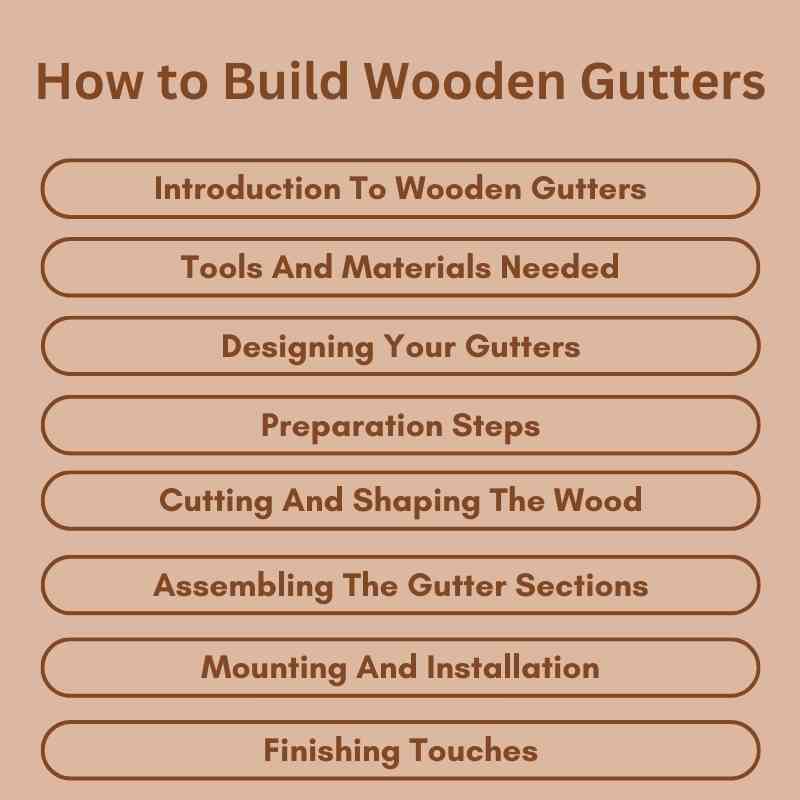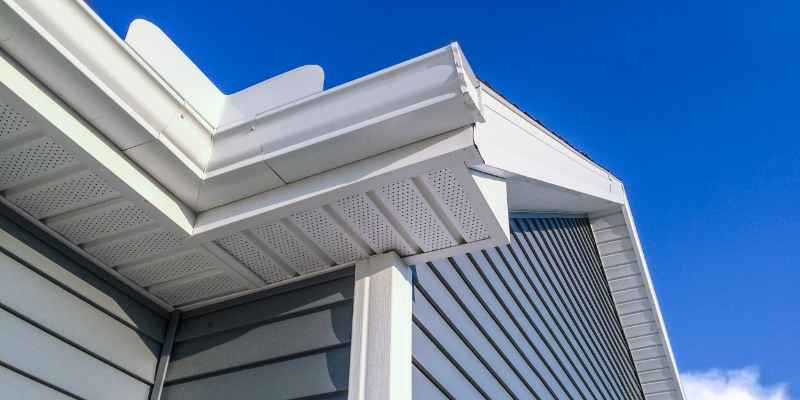To build wooden gutters, start by choosing rot-resistant wood, such as cedar. Then, cut the wood into appropriate lengths and assemble them to form a sloped channel.
Wooden gutters offer a unique blend of aesthetic appeal and functionality. They can enhance the look of your home while providing effective water drainage. Building your own gutters allows for customization to suit your specific needs. Unlike standard metal options, wooden gutters can complement your property’s design perfectly.
Understanding the right materials and techniques is crucial for durability and performance. With the right tools and a bit of patience, anyone can craft wooden gutters that will last for years. This guide will walk you through the necessary steps to create your own wooden gutters efficiently.
Introduction To Wooden Gutters
Wooden gutters bring a unique charm to any home. They have a classic look that many love. Using wood adds warmth and character. People appreciate their traditional style. Wooden gutters can match the house’s aesthetic beautifully.
Benefits of choosing wood include easy customization. You can shape and size them as needed. Wood is also environmentally friendly compared to plastic. It naturally blends with outdoor elements. With proper care, wooden gutters last for many years.
Another advantage is the ease of repair. If damage occurs, fixing wooden gutters is simple. This makes them a practical choice for many homeowners.

Tools And Materials Needed
Gathering the right tools is key to building wooden gutters. Essential tools include a saw, drill, and measuring tape. A level ensures proper alignment. Don’t forget safety gear like gloves and goggles.
Selecting the right wood is crucial. Choose cedar or redwood for durability. These types resist decay and pests. For sealants, use a high-quality waterproof sealant. This protects the wood from moisture.
| Tool/Material | Purpose |
|---|---|
| Saw | Cut wood to desired lengths |
| Drill | Make holes for screws |
| Measuring Tape | Measure wood accurately |
| Waterproof Sealant | Protect wood from moisture |
Designing Your Gutters
Start by determining the length and width of your gutters. Measure the roof’s edge to find the right size. A proper slope helps water flow away. Generally, a slope of 1 inch for every 10 feet works well.
Next, think about your home’s style. Choose materials that match your house’s look. For example, wood gutters can be painted or stained to fit your design. Use colors that blend with your home. This creates a cohesive appearance.
| Aspect | Tip |
|---|---|
| Dimensions | Measure roof edges carefully. |
| Slope | Use a 1:10 ratio for best results. |
| Aesthetics | Choose colors to match your home. |
Preparation Steps
Before starting, prioritize safety. Use protective gear like gloves and goggles. Ensure the work area is well-lit and free from clutter. This reduces the risk of accidents.
Check your tools. Make sure they are sharp and in good condition. A dull tool can slip and cause injuries. Keep a first aid kit nearby for emergencies.
Secure the ladder if you need it. Always have someone to assist you. Lastly, understand the type of wood you will use. Some woods are more durable and weather-resistant than others.
Cutting And Shaping The Wood
Cutting wood for gutters requires precision. Start with a measuring tape to get accurate lengths. Use a saw to cut the wood pieces. Make sure to wear safety goggles while cutting.
After cutting, focus on shaping the edges. Use a sander for smooth edges. Sanding prevents splinters and helps fit the pieces better. A router can create rounded edges for a snug fit.
Check each piece for alignment. Adjust as necessary for a perfect match. This will ensure proper drainage and stability. Remember, a snug fit is key for effective wooden gutters.
Assembling The Gutter Sections
Join wooden gutter sections using strong wood glue. Clamps help hold pieces together while drying. Use screws for added strength. Place screws at an angle for better grip.
To ensure a seamless look, sand the edges before joining. This makes the joints less visible. Fill any gaps with wood filler for a smooth finish. After drying, sand again for a perfect surface.
To create leak-proof joints, apply a waterproof sealant around the edges. This helps prevent water from escaping. Test the joints with water to ensure no leaks are present.
Mounting And Installation
To secure gutters to the roofline, use strong brackets. Place them every two feet for support. Ensure they are level for proper drainage. Adjust the angle slightly for optimal water flow.
Align the gutters so water flows toward the downspouts. Test the slope by pouring water in the gutter. It should drain quickly without pooling. Check all joints for leaks and seal them properly.
Use wood screws to attach the gutters firmly. Avoid using nails, as they can pull out over time. Regularly inspect the installation for any signs of wear.
Finishing Touches
Proper sealing and waterproofing are crucial for wooden gutters. Use a high-quality sealant to protect against moisture. Apply multiple coats for better durability. Ensure all joints and seams are well sealed.
Installing downspouts helps direct water away from your home. Choose the right size downspouts based on your gutter width. Position them at the lowest points for effective drainage.
Drainage systems prevent water pooling near your foundation. Consider adding drainage pipes that lead to a safe area. Regularly check for clogs or blockages to maintain flow.
Maintenance And Care
Regular cleaning keeps your wooden gutters in great shape. Remove leaves and dirt often. Use a soft brush or cloth to avoid scratches. Clear debris from downspouts to prevent clogs. Always check for standing water, as it can cause damage.
To extend the life of wooden gutters, consider these longevity practices. Apply a protective sealant yearly. This helps resist moisture and rot. Inspect for signs of wear and replace damaged sections promptly. Keeping gutters painted can also prevent wood decay.
Troubleshooting Common Issues
Leaks and overflows can happen with wooden gutters. Inspect the joints and seams regularly. Seal any cracks with a strong waterproof sealant. Ensure proper slope to direct water flow. This helps prevent water pooling.
Wood rot can weaken your gutters. Choose rot-resistant wood for better durability. Apply a protective sealant to extend the wood’s life. Regularly check for signs of decay or damage.
Pests can be a problem in wooden gutters. Keep the area clean and free of debris. Consider using natural repellents to deter insects. Regular inspections help catch issues early.

Frequently Asked Questions
How Do You Make Wooden Gutters?
To make wooden gutters, start by selecting durable wood, such as cedar. Cut the wood into desired lengths and shape the pieces to form a trough. Assemble using waterproof adhesive and secure with screws. Finally, seal the joints with caulk to prevent leaks and ensure longevity.
What Materials Do I Need For Wooden Gutters?
You’ll need durable wood, screws, waterproof adhesive, and caulk. Additionally, gather tools like a saw, drill, and measuring tape. Ensure you have sandpaper for smoothing edges and a level to ensure proper alignment. These materials will help create effective and long-lasting wooden gutters.
Are Wooden Gutters Better Than Metal Ones?
Wooden gutters offer unique aesthetic appeal and blend well with natural surroundings. They can be more environmentally friendly and are easier to customize. However, they require regular maintenance and treatment against rot. Ultimately, the choice depends on personal preference and specific project requirements.
How Long Do Wooden Gutters Last?
With proper care, wooden gutters can last 20 years or more. Regular maintenance, including cleaning and sealing, is essential to prevent rot and damage. Choosing high-quality wood and applying protective finishes also extends their lifespan. Always inspect for signs of wear to ensure longevity.
Conclusion
Building wooden gutters is a rewarding project that enhances your home’s charm. With proper planning and materials, you can create functional and aesthetically pleasing gutters. Remember to maintain them regularly for longevity. Embrace this eco-friendly option and enjoy the benefits it brings to your property for years to come.

